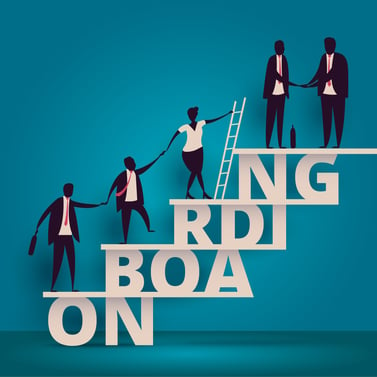Companies with the Best Onboarding Programs Elevate Their Employee Experience with Role Clarification
The Great Resignation has left organizations understaffed and under-skilled, prompting many employers to rethink their employee experience strategies. The term “employee experience” describes an employee’s interactions throughout their employment, from their workplace culture experiences to their experience exiting. As organizations increasingly struggle to attract and retain talent, the onboarding component of an employee experience is crucial—especially considering that one in three workers quit within the first 90 days. Companies with the best onboarding programs are having greater success with their employee retention results.

Role clarification is an effective way to elevate your employee onboarding program, helping clearly define employee expectations. While defining roles might seem like common sense, most employees that leave within the first 90 days do so because their day-to-day role was not as expected. By investing some resources into role clarification, you can save costs associated with turnover and build a more productive, satisfied workforce.
Here's a deeper dive into what role clarification is and how you can use it to improve your onboarding program and employee experience strategy.
What is role clarification?
Role clarification describes the process of clearly outlining what an organization expects of an employee and what the employee can expect of the organization—or more directly, their manager or team leader. In many cases, employee dissatisfaction and conflict stem from a misunderstanding between team members and leaders about role expectations.
Defining employee expectations establishes trust and clear communication between employees and their managers. It also keeps employees more engaged and productive in their work. Role clarification reduces turnover, eliminating role ambiguity that can cause stress and burnout. Role clarification involves defining several aspects of an employee onboarding experience, including:
-
Communications. For example, role clarification determines preferred communication methods (such as email versus in-person), how often communications are expected, who makes decisions and how, parameters around giving and receiving feedback, how to navigate conflict, and what level of detail to expect while communicating.
-
Role requirements. Employers should set clear guidelines about the employee’s daily tasks, which tasks are the highest priority, what their goals or key performance indicators are, and who completes tasks in situations where there could be role overlap.
-
Resources. To ensure that employees complete their tasks successfully, role clarification outlines which resources, such as software, an employee needs for their role, how to access these resources, and who to consult if support is required.
-
Learning opportunities. Employees—especially new hires—need to understand when and how they will have access to professional development. Role clarification defines when to expect learning opportunities, how these opportunities will be delivered, processes for determining skills gaps and desires, and what time or financial resources the employee can expect to contribute to learning sessions.
How to apply role clarification
To integrate role clarification into your employee onboarding experience strategy, review what each of the above categories—communications, role requirements, resources, and learning opportunities—looks like for each role. This typically involves consultation with other team members and employees already in each role. At this step, role clarification is a good opportunity to identify skills gaps and start planning learning opportunities to fill them. When applying role clarification, make things as explicit as possible. It’s better to be overly detailed than to leave room for assumptions.
You can also structure role clarification across a position’s different levels—for example, from Junior Sales Representative to Sales Leader. This often makes it easier to determine which skills employees need as they progress through your organization. It also gives you a clear path to show employees and candidates who want to know about available learning and promotional opportunities.
When hiring new staff, integrate role clarification from the very beginning. For example, incorporate role clarity into the job posting as well as job interviews. During an employee onboarding program, the employee should gain a comprehensive understanding of their role expectations, from communications to learning opportunities. Role clarification can be offered through written resources, such as an employee handbook, in-person sessions, or a combination. Engaging an instructional designer to improve your employee onboarding and training programs is a good approach to ensure your learning programs achieve your performance goals.
Role clarification doesn’t end after an employee onboarding program. Role clarity should also be considered during employee performance reviews and promotions. You should also revisit your role clarification strategy as your organization navigates business strategy changes, restructuring, and acquisitions.
Conclusion
If your employees seem unsure about how to prioritize tasks—or if workplace conflict stems from task delegation issues—your organization probably lacks role clarity. A role clarification strategy will help your organization define expectations between employees and their leaders, from role requirements to communications. By integrating role clarification into your onboarding program, you can improve employee productivity, maintain a happier workforce, and avoid the burden of high turnover.
Ready to get started with Employee Onboarding and not sure where to begin?
Get our FREE DOWNLOAD: "Employee Onboarding Handbook"


